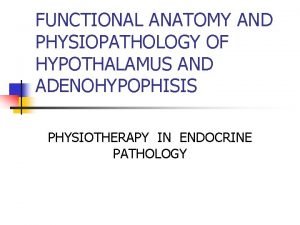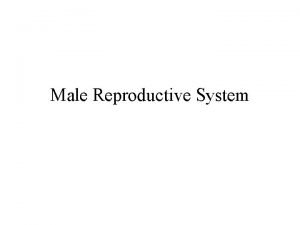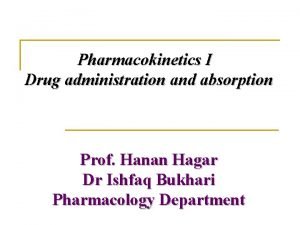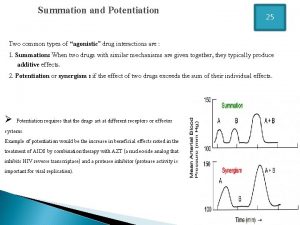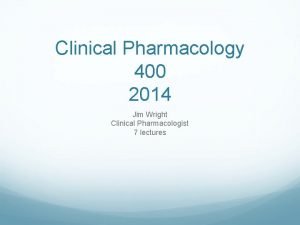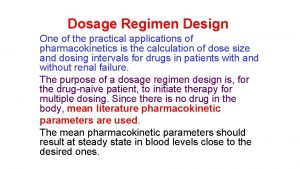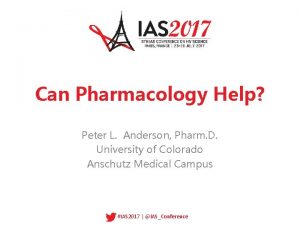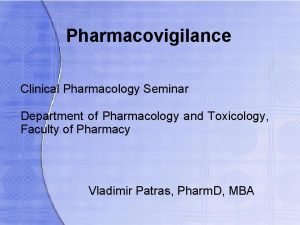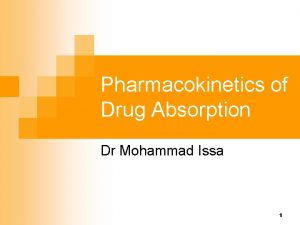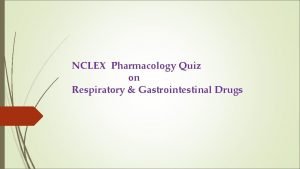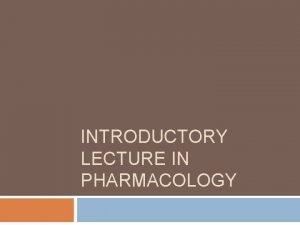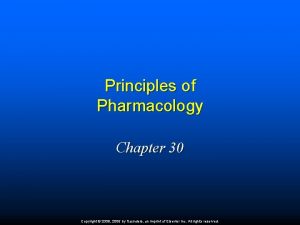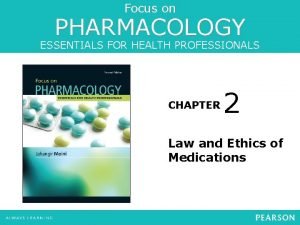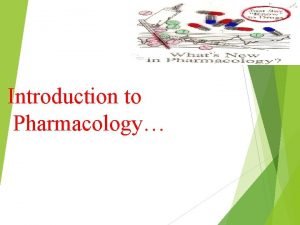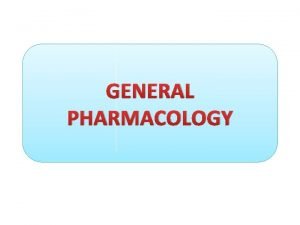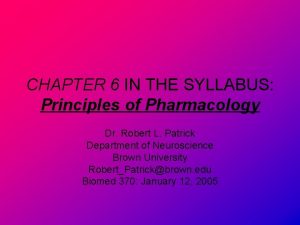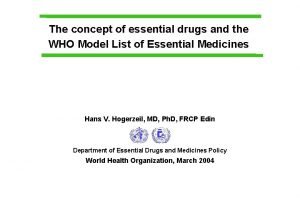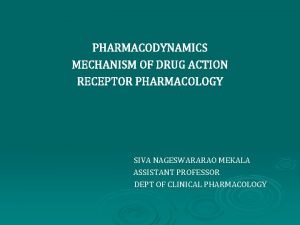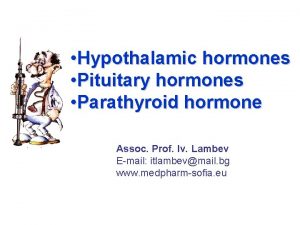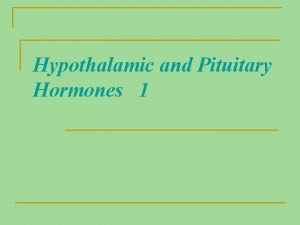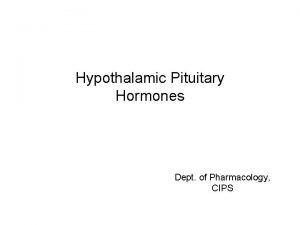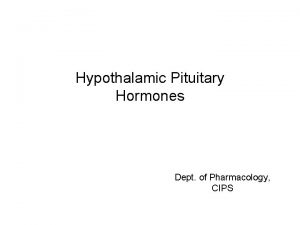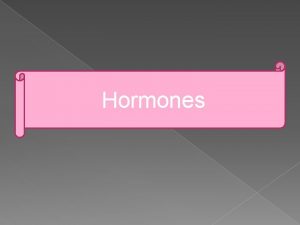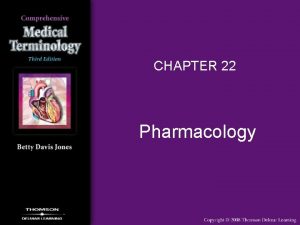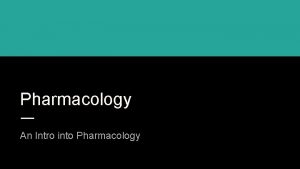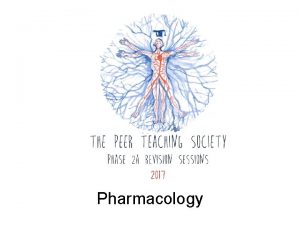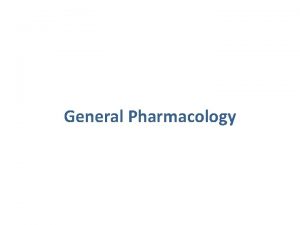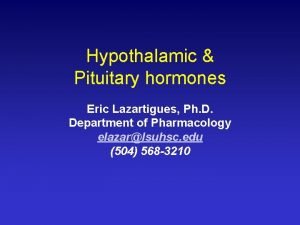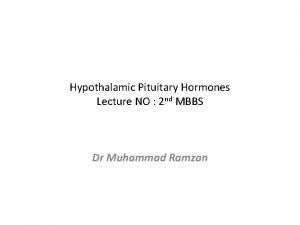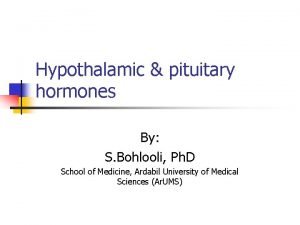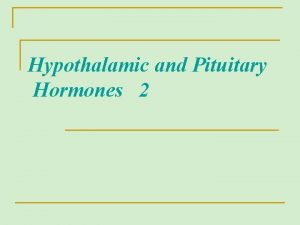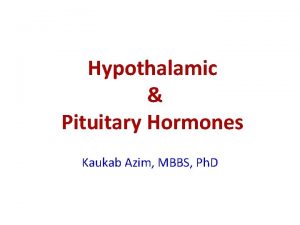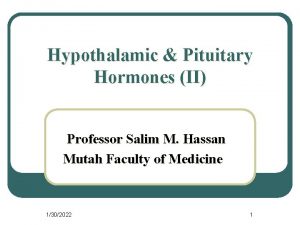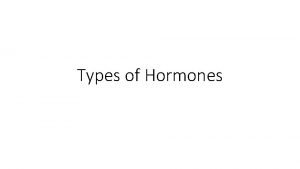Pharmacology of Hypothalamic Hormones Pharmacology of Hypothalamic Hormones

























- Slides: 25

Pharmacology of Hypothalamic Hormones

Pharmacology of Hypothalamic Hormones • The neuroendocrine system, which is controlled by the pituitary and hypothalamus, coordinates body functions by transmitting messages between individual cells and tissues. • This contrasts with the nervous system, which communicates locally through electrical impulses and neurotransmitters directed through neurons to other neurons or to specific target organs, such as muscle or glands.

• Nerve impulses generally act within milliseconds. The endocrine system releases hormones into the bloodstream, which carries chemical messengers to target cells throughout the body. Hormones have a much broader range of response time than do nerve impulses, requiring from seconds to days, or longer, to cause a response that may last for weeks or months. • The two regulatory systems are closely interrelated. For example, in several instances, the release of hormones is stimulated or inhibited by the nervous system, and some hormones can stimulate or inhibit nerve impulses.


Hypothalamic and Anterior Pituitary Hormones • The hormones secreted by the hypothalamus and the pituitary are all peptides or low molecular weight proteins that act by binding to specific receptor sites on their target tissues. • The hormones of the anterior pituitary are regulated by neuropeptides that are called either “releasing” or “inhibiting” factors or hormones. • These are produced in the hypothalamus, and they reach the pituitary by the hypophyseal portal system. • The interaction of the releasing hormones with their receptors results in the activation of genes that promote the synthesis of protein precursors.

Hypothalamic and Anterior Pituitary Hormones • The protein precursors then undergo posttranslational modification to produce hormones, which are released into the circulation. • Each hypothalamic regulatory hormone controls the release of a specific hormone from the anterior pituitary. Although a number of pituitary hormone preparations are currently used therapeutically for specific hormonal deficiencies, most of these agents have limited therapeutic applications. • Hormones of the anterior and posterior pituitary are administered intramuscularly (IM), subcutaneously, or intranasally because their peptidyl nature makes them susceptible to destruction by the proteolytic enzymes of the digestive tract.


A. Adrenocorticotropic hormone (corticotropin) • Corticotropin-releasing hormone (CRH) is responsible for the synthesis and release of the peptide proopiomelanocortin by the pituitary. • Adrenocorticotropic hormone (ACTH) or corticotropin is a product of the posttranslational processing of this precursor polypeptide. • CRH is used diagnostically to differentiate between Cushing syndrome and ectopic ACTH-producing cells. • Normally, ACTH is released from the pituitary in pulses with an overriding diurnal rhythm, with the highest concentration occurring in the early morning and the lowest in the late evening. • Stress stimulates its secretion, whereas cortisol acting via negative feedback suppresses its release

Mechanism of action ACTH binds to receptors on the surface of the adrenal cortex, thereby activating G protein–coupled processes that ultimately stimulate the ratelimiting step in the adrenocorticosteroid synthetic pathway (cholesterol to pregnenolone; • This pathway ends with the synthesis and release of the adrenocorticosteroids and the adrenal androgens. •


Therapeutic Uses • The availability of synthetic adrenocorticosteroids with specific properties has limited the use of corticotropin mainly to serving as a diagnostic tool for differentiating between primary adrenal insufficiency (Addison disease, associated with adrenal atrophy) and secondary adrenal insufficiency (caused by the inadequate secretion of ACTH by the pituitary). • Therapeutic corticotropin preparations are extracts from the anterior pituitaries of domestic animals or synthetic human ACTH. • Cosyntropin [ko-sin-TROEpin], is preferred for the diagnosis of adrenal insufficiency. • ACTH is also used in the treatment of infantile spasm (West syndrome).

Adverse effects • Short-term use of ACTH for diagnostic purposes is usually well tolerated. • With longer use, toxicities are similar to those of glucocorticoids and include hypertension, peripheral edema, hypokalemia, emotional disturbances, and increased risk of infection

B. Growth hormone (somatotropin) • Somatotropin is a large polypeptide that is released by the anterior pituitary in response to growth hormone (GH)-releasing hormone produced by the hypothalamus • Secretion of GH is inhibited by another hypothalamic hormone, somatostatin • GH is released in a pulsatile manner, with the highest levels occurring during sleep.

B. Growth hormone (somatotropin) • With increasing age, GH secretion decreases, accompanied by a decrease in lean muscle mass. • Somatotropin influences a wide variety of biochemical processes (for example, cell proliferation and bone growth are promoted). • Synthetic human GH (somatropin [soe-mah-TROE pin]) is produced using recombinant DNA technology.

Mechanism of action • Although many physiologic effects of GH are exerted directly at its targets, others are mediated through the somatomedins —insulin-like growth factors 1 and 2 (IGF-1 and IGF-2). • In acromegaly (a syndrome of excess GH due to hormone-secreting tumors), IGF-1 levels are consistently high, reflecting elevated GH.


Therapeutic uses • Somatropin is used in the treatment of GH deficiency or growth failure in children. ü GH administered to adults increases lean body mass, bone density, and skin thickness, whereas adipose tissue is decreased. ü Many consider GH an “antiaging” hormone. This has led to off-label use of GH by older individuals and by athletes seeking to enhance performance. • Somatropin is administered by subcutaneous or IM injection. Although the half-life of GH is short (approximately 25 minutes), it induces the release of IGF-1 from the liver, which is responsible for subsequent GH-like actions.

Adverse effects • Adverse effects of somatropin include pain at the injection site, edema, arthralgias, myalgias, flu-like symptoms, and an increased risk of diabetes. • Somatropin should not be used in pediatric patients with closed epiphyses, patients with diabetic retinopathy.

C. Somatostatin (Growth hormone-inhibiting hormone) • In the pituitary, somatostatin binds to receptors that suppress GH and thyroid-stimulating hormone release. • Originally isolated from the hypothalamus, somatostatin is a small polypeptide that is also found in neurons throughout the body as well as in the intestine, stomach, and pancreas. • Somatostatin not only inhibits the release of GH but also that of insulin, glucagon, and gastrin. • Octreotide [ok-TREE-ohtide] and lanreotide [lan-REE-oh-tide] are synthetic analogs of somatostatin. • Their half-lives are longer than that of the natural compound, and depot formulations are available, allowing for administration once every 4 weeks. • They have found use in the treatment of acromegaly.

• An intravenous infusion of octreotide is also used for the treatment of bleeding esophageal varices. • Adverse effects of octreotide include diarrhea, abdominal pain, flatulence and nausea. • Gallbladder emptying is delayed, and asymptomatic cholesterol gallstones can occur with long-term treatment. • Acromegaly that is refractory to other modes of therapy may be treated with pegvisomant (peg-VIH-soe-mant), a GH receptor antagonist.

D. Gonadotropin-releasing hormone • Pulsatile secretion of gonadotropin-releasing hormone (Gn. RH) from the hypothalamus is essential for the release of the gonadotropins folliclestimulating hormone (FSH) and luteinizing hormone (LH) from the anterior pituitary. • However, continuous administration of Gn. RH inhibits gonadotropin release through down-regulation of the Gn. RH receptors on the pituitary. Continuous administration of synthetic Gn. RH analogs, such as leuprolide [loo-PROE-lide], goserelin [GOE-se-rel-in], nafarelin [NAFF-a-rel-in], and histrelin [his. TREL-in], is effective in suppressing production of the gonadotropins. • Several of these agents are available as implantable formulations that provide convenient continuous delivery of the drug. Suppression of gonadotropins, in turn, leads to reduced production of gonadal steroid hormones (androgens and estrogens).

• These agents are effective in the treatment of prostate cancer, endometriosis, and precocious puberty. • In women, the Gn. RH analogs may cause hot flushes and sweating, as well as diminished libido, depression, and ovarian cysts. q Contraindicated: • In pregnancy and breast-feeding. • In men, they initially cause a rise in testosterone that can result in bone pain. • Hot flushes, edema, gynecomastia, and diminished libido may also occur.

E. Gonadotropins • The gonadotropins (FSH and LH) are glycoproteins that are produced in the anterior pituitary. The regulation of gonadal steroid hormones depends on these agents. They find use in the treatment of infertility. • Menotropins [men-oh-TROE-pinz] (also known as human menopausal gonadotropins or h. MG) are obtained from the urine of postmenopausal women and contain both FSH and LH. • Urofollitropin [yoor-ohfol- li-TROE-pin] is FSH obtained from postmenopausal women and is devoid of LH. • Follitropin [fol-ih-TROE-pin] alfa and follitropin beta are human FSH products manufactured using recombinant DNA technology.

• Human chorionic gonadotropin (h. CG) is a placental hormone that is excreted in the urine of pregnant women. • The effects of h. CG and choriogonadotropin [kore-ee-oh-goe-NAD-oh-troe-pin] alfa (made using recombinant DNA technology) are essentially identical to those of LH. • All of these hormones are injected via the IM or subcutaneous route. • Injection of h. MG or FSH products over a period of 5 to 12 days causes ovarian follicular growth and maturation, and with subsequent injection of h. CG, ovulation occurs. • Adverse effects include ovarian enlargement and possible ovarian hyperstimulation syndrome, which may be life threatening. • Multiple births are not uncommon.

F. Prolactin • Prolactin is a peptide hormone that is also secreted by the anterior pituitary. Its primary function is to stimulate and maintain lactation. • In addition, it decreases sexual drive and reproductive function. • Its secretion is inhibited by dopamine acting at D 2 receptors. • Drugs that act as dopamine antagonists (for example, metoclopramide and antipsychotics such as risperidone) can increase the secretion of prolactin. • Hyperprolactinemia, which is associated with galactorrhea and hypogonadism, is treated with D 2 receptor agonists, such as bromocriptine and cabergoline. Both of these agents also find use in the treatment of pituitary microadenomas. Bromocriptine is also indicated for the treatment of type 2 diabetes. • Among their adverse effects are nausea, headache and, sometimes, psychiatric problems.
 Adenohypophisis
Adenohypophisis Hypothalamic hormones
Hypothalamic hormones What are the tropic hormones
What are the tropic hormones Hypothalamohypophyseal
Hypothalamohypophyseal Reproductive system conclusion
Reproductive system conclusion Portal circulation
Portal circulation Advantages of iv route of drug administration
Advantages of iv route of drug administration First pass effect
First pass effect Drug summation examples
Drug summation examples Clinical pharmacology residency
Clinical pharmacology residency Dosage regimen design
Dosage regimen design Pharmacology tutor anderson
Pharmacology tutor anderson Clinical pharmacology seminar
Clinical pharmacology seminar Loading dose
Loading dose Respiratory pharmacology quiz
Respiratory pharmacology quiz What is pharmacology
What is pharmacology Chapter 30 principles of pharmacology
Chapter 30 principles of pharmacology Focus on pharmacology
Focus on pharmacology Branches of pharmacology
Branches of pharmacology Significance of protein binding
Significance of protein binding Toxicology and applied pharmacology
Toxicology and applied pharmacology What is pharmacology
What is pharmacology Essential drug concept in pharmacology
Essential drug concept in pharmacology Mechanism of drug action
Mechanism of drug action Creatinine clearance formula
Creatinine clearance formula Annual review of pharmacology and toxicology
Annual review of pharmacology and toxicology
